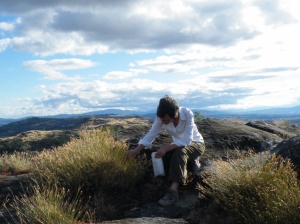Nabais, P., Oliveira, J., Pina, F., Teixeira, N., Brás, N., de Freitas, V., Clemente, A., Rangel, M., Silva, M.S. & Melo, M.J. (2020) A 1000-year-old mystery solved: unlocking the molecular structure for the medieval blue from Chrozophora tinctoria, also known as folium.
Science Advances,
6(16), eaaz7772. DOI:10.1126/sciadv.aaz7772 (IF2020 14,136; Q1 Multidisciplinary Sciences)
The molecular structure of the medieval watercolor known as folium has finally been solved in the 21st century. The interdisciplinary approach taken was the key to producing extracts that had been prepared following medieval instructions, and shows the blue/purple chromophore as the major dye in Chrozophora tinctoria fruits (shell). A multi-analytical characterization of its structure was made using HPLC-DAD-MS, GC-MS, NMR (1H, 13C, COSY, HSQC, HMBC, INADEQUATE), and computational studies. The results demonstrate that the blue compound corresponds to 6′-hydroxy-4,4′-dimethoxy-1,1′-dimethyl-5′-{[3,4,5-trihydroxy-6-(hydroxymethyl)tetrahydro-2H-pyran-2-yl]oxy}-[3,3′-bipyridine]-2,2′,5,6(1H,1′H)-tetraone, a hermidin derivative, which we named chrozophoridin. Experimental data and computational modeling studies show that this mono-glycosylated dimer is represented by two stable isomers (atropisomers). This is an indispensable piece of knowledge for the characterization of this medieval dye in works of art such as medieval manuscript illuminations and for testing its stability and contributes to the preservation of our cultural heritage.

